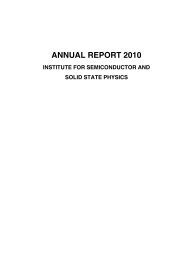Kinetic and Strain-Induced Self-Organization of SiGe ...
Kinetic and Strain-Induced Self-Organization of SiGe ...
Kinetic and Strain-Induced Self-Organization of SiGe ...
You also want an ePaper? Increase the reach of your titles
YUMPU automatically turns print PDFs into web optimized ePapers that Google loves.
12 CHAPTER 1. SILICON-GERMANIUM MATERIAL SYSTEM<br />
Figure 1.9: Lattice parameters <strong>of</strong> Si1−xGex alloys <strong>and</strong> deviation from Vegard’s<br />
rule [51].<br />
� Source: <strong>SiGe</strong> Vegards-rule.jpg<br />
1.4 Silicon Germanium Alloys (Si1−xGex)<br />
Silicon <strong>and</strong> germanium form a continuous series <strong>of</strong> solid solutions Si1−xGex providing a grad-<br />
ual change in some parameters (e.g. lattice parameter a) with x ranging from 0 to 1 [3].<br />
The lattice parameter a<strong>SiGe</strong> <strong>of</strong> Si1−xGex alloys shows a small deviation from Vegard’s rule,<br />
i.e. from the linearity between the lattice constants <strong>of</strong> pure Si <strong>and</strong> Ge. According to ex-<br />
periments by Dismukes et al. [51] (see Fig. 1.9) <strong>and</strong> theoretical Monte Carlo simulations <strong>of</strong><br />
Si1−xGex alloys the lattice constant for Si1−xGex alloys a<strong>SiGe</strong> lies below Vegard’s rule [5].<br />
1.4.1 B<strong>and</strong>structure <strong>of</strong> <strong>SiGe</strong>-Heterostructures<br />
The lattice mismatch (4.2%) strain between Si <strong>and</strong> Ge enables b<strong>and</strong> engineering for <strong>SiGe</strong>-<br />
heterostructures. Due to the different symmetries in Si- <strong>and</strong> Ge-b<strong>and</strong> structure the <strong>SiGe</strong>-<br />
alloy b<strong>and</strong>structure shows a cross-over in the lowest conduction b<strong>and</strong> edge from Si-like [100]-<br />
symmetry to Ge-like [111]-symmetry at x ∼ 0.85 [3]. Fig. 1.10 [6, 52] shows the compositional<br />
dependence <strong>of</strong> the indirect energy gap for unstrained Si1−xGex alloys with the change from<br />
the conduction b<strong>and</strong> (CB) minimum at the ”∆”-point (Si-like) to the L-point (Ge-like) (upper<br />
curve in Fig. 1.10). The two lower curves show the vast influence <strong>of</strong> strain for pseudomorphic<br />
<strong>SiGe</strong>-layers on a Si-substrate. The in-plane compressively strained <strong>SiGe</strong>-layers show a signif-<br />
icantly lowered b<strong>and</strong>gap with a splitting <strong>of</strong> the valence b<strong>and</strong> (VB) maximum in heavy-hole<br />
(HH) <strong>and</strong> light-hole (LH) b<strong>and</strong>. [6, 52]











